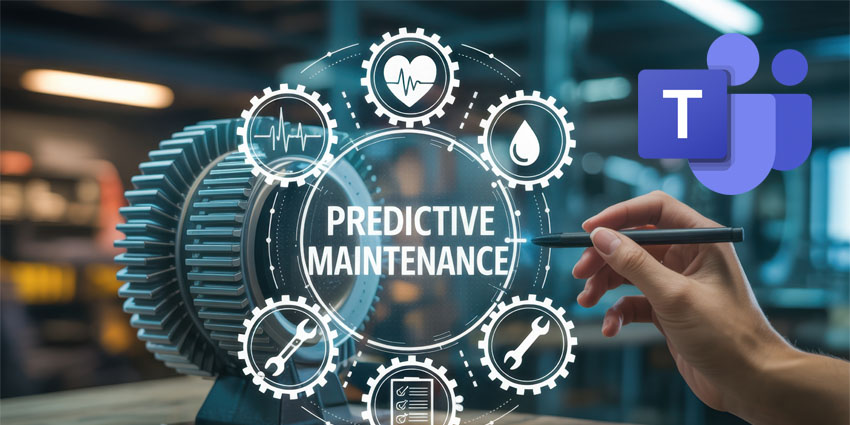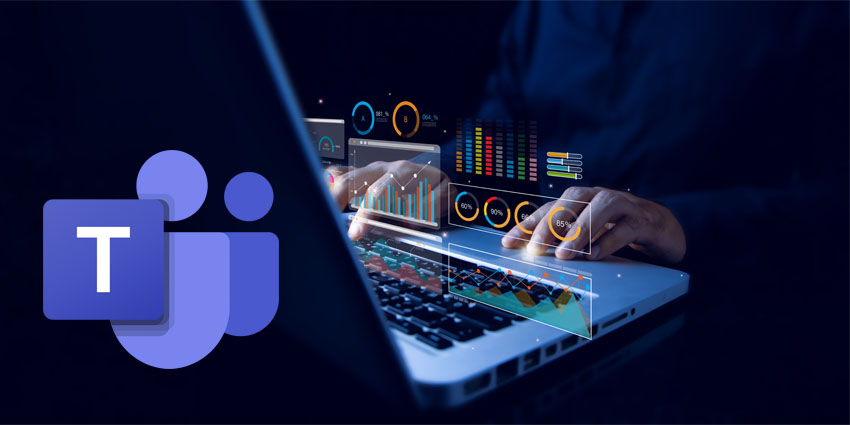Every operations leader knows that one bad breakdown can undo months of progress. A line stalls. A turbine falters. The phone starts lighting up. Somewhere between the maintenance schedule and the data dashboard, a signal got missed.
Across industries, those moments are costing billions. Global manufacturers alone lose around $50 billion every year to unplanned downtime. Numbers in the utilities sector are no better. Yet studies show that AI predictive maintenance programs can cut unexpected outages by nearly half, extend equipment life by up to 40 percent, and dramatically reduce service costs. The technology works. The problem is coordination.
Factories and utilities now collect a flood of IoT data every second. But it’s not the data that keeps the lights on; it’s how fast people act on it. Utilizing Microsoft Teams for predictive maintenance strategies may be the solution. The platform is now becoming the digital control room for maintenance, bringing engineers, operators, and analysts together in the same space to make decisions in real-time.
At Hannover Messe 2025, Microsoft and its partners showed what that looks like in action: Microsoft Fabric weaving scattered data into a single thread that connects sensors to Teams, Teams to Power BI, and insights to action. It’s not about predicting failures anymore; it’s about empowering people to prevent them together.
- Measuring and Maximizing Microsoft Teams ROI: The Enterprise Framework
- How CIOs Can Balance Microsoft Teams Governance with Productivity
From Reactive Maintenance to Connected Intelligence
A decade ago, maintenance was largely based on guesswork wrapped in routine. Crews worked from fixed schedules, patterns held steady, and equipment usually behaved the same way it had for years. Then everything changed.
Production lines have gotten messy. They’re too complex and too connected for paper lists or gut instinct to handle anymore. A single issue can quickly ripple through an entire supply chain. Most manufacturers still lose close to 32 hours of production every month because something unexpected stops working. In utilities, even a short outage can shake public trust.
Companies are realizing that no amount of manual monitoring can keep pace with that level of volatility. That’s why leaders in energy and manufacturing are leveraging AI predictive maintenance to bring intelligence and foresight to the process, and utilizing collaboration tools like Microsoft Teams to turn that insight into immediate action.
At E.ON, leaders say switching from a centralized to a decentralized energy supply wouldn’t be possible without digital management of power grids and intelligent collaboration tools. With Power BI dashboards inside Microsoft Teams, the company’s technicians now monitor infrastructure serving 48 million customers, identifying and resolving anomalies before they escalate into incidents.
In Japan, JERA built an AI-powered detection system using Azure OpenAI Services to remotely monitor plants and flag issues early. In Brazil, Furnas used predictive analytics to anticipate faults that once triggered penalties from regulators.
Together, these stories show predictive maintenance isn’t a software upgrade. It’s a mindset shift from reacting to connecting, from waiting for failure to preventing it altogether.
Power Platform and Microsoft Teams for Predictive Maintenance
Predictive maintenance isn’t just about sensors or dashboards. It’s about how people use information the moment it appears. In most plants or utilities, that’s where things still fall apart. Data exists, but it’s scattered.
Using Microsoft Teams for predictive maintenance strategies means teams can bring together every piece of that puzzle. It’s where a voltage dip, a sensor alert, and a maintenance ticket all land in one shared view.
Inside Teams, engineers use Power BI to track live asset data while Power Automate pushes updates when a reading looks off. Power Apps make it easy to log issues straight from the field, with photos or notes added on the spot. Behind all this, Microsoft Fabric ties it together, pulling IoT feeds, ERP records, and maintenance history into a single, reliable thread.
That simplicity is paying off. Fincantieri, the Italian shipbuilder, used Azure Data Explorer to shift from reactive to predictive maintenance. The result: 25 percent fewer interventions and smarter inventory planning.
Rolls-Royce relies on Azure Databricks and AI to spot early warning signs in engines before performance drops. Equinor built its own internal “Center for Enablement” on Power Platform, letting teams design low-code maintenance apps. And ACWA Power uses Azure AI and IoT Hub to predict failures, cut downtime, and improve safety across its energy plants.
The real breakthrough wasn’t just in the analytics. It was in connecting the data, the decisions, and the people who make them.
Turning Data into Action: Predictive Maintenance that Works
Most maintenance programs lose momentum in the space between insight and action. Collecting data is easy. Making a decision before something breaks is where the real work begins.
That’s where AI predictive maintenance solutions make a difference in a Microsoft ecosystem. With Microsoft Teams serving as the command center, alerts are delivered to the right people at the right moment.
IoT sensors stream data into Microsoft Fabric, where AI models built on Azure Machine Learning identify patterns that indicate potential failure. If a reading exceeds a certain threshold, Power Automate triggers, creating a ticket, tagging the relevant engineer in Teams, and sending a brief summary to operations leads. Everyone sees the same context instantly.
Inside Teams, Power BI dashboards keep everyone aligned. Charts refresh in real time, showing asset health, performance, and developing trends. Engineers can drop photos or quick video clips directly into a Teams chat, while supervisors use Copilot to summarize inspection logs or retrieve recent work orders with a simple request. It’s already making a difference for companies that have implemented it.
At E.ON, technicians monitor grid data for 48 million customers through Power BI in Teams, catching voltage irregularities before outages occur. Ma’aden, the Saudi mining group, saves around 2,200 hours a month by using Copilot to automate reporting and analysis. MAIRE, an Italian engineering leader, cut repetitive admin by more than 1,600 hours per month using AI to generate reports and inspection notes.
For teams, this is about clearing the noise so that human expertise can focus on what actually matters: fixing the problem, not chasing paperwork.
- Unlocking Microsoft Teams Phone’s True Business Value
- Microsoft Teams for Field Service: The Command Center Transforming Operations
The Future of Predictive Maintenance with Microsoft Teams
The next stage of predictive maintenance involves transitioning from staying one step ahead to eliminating steps altogether.
What started as simple AI tools spotting faults before they happen is evolving into something more intelligent and autonomous. Microsoft is already showing where this is heading. Its Maintenance Prediction Agent, part of the Power Platform scenario library, demonstrates how alerts can trigger not just a Teams notification but an entire workflow, from diagnosis to work order.
Instead of engineers reacting to dashboards, Microsoft Teams for predictive maintenance becomes the digital command post where AI copilots, IoT feeds, and Power Automate all work together. Microsoft Fabric acts as the thread connecting it all, drawing data from IoT devices, enterprise systems, and maintenance records, so models can continue to learn.
You can already see how fast this is moving. At Hannover Messe 2025, Microsoft presented “Industrial AI in Action,” demonstrating how partners such as AVEVA, Kongsberg, and Databricks utilized Fabric to stream live data from factory floors directly into the hands of decision-makers. Companies such as Equinor and ACWA Power are putting that same idea to work, using AI to plan and predict maintenance across enormous operations. Their systems now flag issues automatically and adjust schedules as performance shifts.
As these AI copilots continue to learn, maintenance teams will spend less time gathering data and more time ensuring that outcomes align with reality. The next wave of predictive maintenance tools will calculate ROI, balance workloads, and continually improve with each use.
Making Microsoft Teams for Predictive Maintenance Work
Even the smartest maintenance software won’t get you far if the basics aren’t solid. Success usually depends on people and process more than the code behind the system.
- Clean the data first: You can’t build trust in your results if the data’s full of gaps or errors. The teams that do this well spend time fixing and linking their information with tools like Microsoft Fabric or Purview.
- Bring IT and operations together: Predictive maintenance falls apart when people work in separate corners. Once Azure IoT Hub, Power BI, and Microsoft Teams are connected, everyone is looking at the same live data instead of guessing. Engineers, analysts, and managers can identify issues simultaneously, discuss them, and resolve them more quickly.
- Automate what you can: Automation should simplify the work, not distance people from it. Use Power Automate to handle repetitive tasks, such as routing alerts or assigning jobs, while maintaining human oversight where it matters most.
- Keep it secure: As systems become more connected, the attack surface grows. Following Microsoft’s latest security guidance and using Teams Premium features, such as advanced audit logging, helps maintain trust across departments.
- Measure the payoff: Define what success looks like early. Track metrics like Mean Time Between Failures, Mean Time to Repair, and cost savings. Once you see those numbers move, momentum follows.
- Give people the tools to build: Real change sticks when it’s built from the ground up. Centrica achieved this by providing teams with access to Microsoft Power Platform, enabling them to create their own maintenance apps. It cut delays and opened the door for ideas nobody at the top would have thought of.
Predictive maintenance only works when people, process, and tech grow together.
Predictive Maintenance as a Sustainability Imperative
The need to keep equipment running is nothing new, but now every hour of uptime means something bigger. It saves power, reduces waste, and keeps companies closer to their sustainability goals. Bringing AI, Power Platform, and Microsoft Teams together for predictive maintenance is now the responsible way to work.
When data, people, and action live in one place, everything starts to flow. Engineers see what leadership sees. Field techs can spot issues before they turn into downtime. It’s the kind of setup that makes teams more connected and operations more sustainable.







